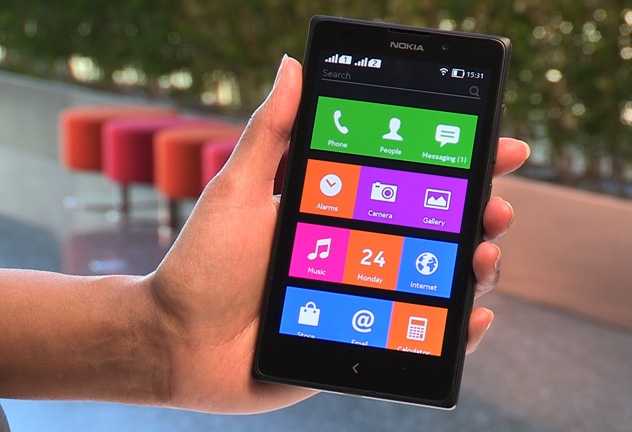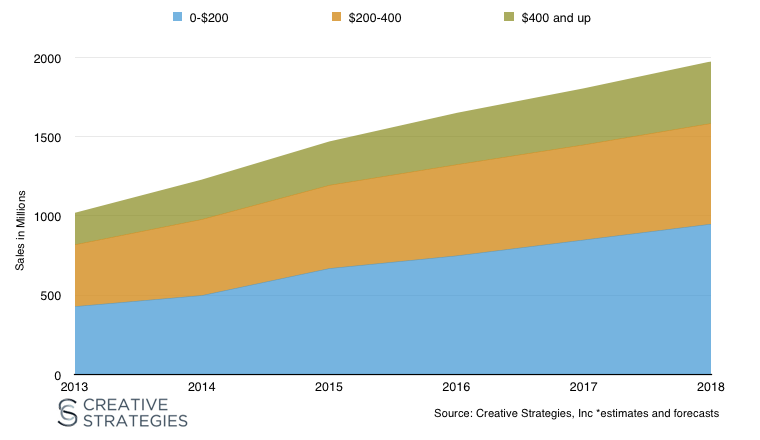
Today at Mobile World Congress, Nokia announced a new family of affordable smartphones called the Nokia X. What is notable is that these devices are not coming from Nokia’s Smart Devices group which creates the Lumia and ships Windows Phone as their smart devices OS. This group within Nokia is the group that sells feature phones, hybrid feature/smart phones known as their Asha line, and now the Nokia X. This group focuses on the lower end of the smartphone market and in particular emerging markets. This group focuses on people in the market for their first mobile/smartphone.
The new lineup of Nokia X devices is competing in one of the fastest growing price bands of the smartphone market. The market for smartphones around the $100 price point is growing at 4X. Let’s look at the growth bands of price tiers for smartphones here is a look at my firm’s estimates.

The lower cost segment is the growth area and where the bulk of the next one billion new smartphone owners will come at this price segment. Nokia is targeting the X family right at this growth area. This group within Nokia has mobile distribution deals in place with over 90% of the world’s markets giving them one of the broadest carrier distribution networks of any global brand. At prices between $89-109, the Nokia X has a massive opportunity.
AOSP vs. Google
What makes the Nokia X family discussion worthy is not necessarily that it is running Android but that it is running Android with Microsoft’s, not Google’s, services tightly integrated into the platform. This sounds like a risk and to a degree it is, however, it is a risk that could pay off. The key question in my mind is not whether Nokia should have shipped AOSP but rather are Microsoft’s services competitive with Google in markets where Google competes. What intrigues me about this move is that Microsoft has stepped right onto Google’s turf, with their own software, and decided to attempt to compete with them on services.
The Nokia X comes with a service comparable to nearly every service Google offers. Outlook for email. Here for Maps. Skydrive for cloud storage, Office 365, Skype, and the Bing search engine. The big question everyone will ask is about apps. To solve that problem, Nokia is shipping their own Android app store as well as the top 5 most popular app stores in certain regions. The Nokia X devices also support side loading of apps that is another popular, yet little talked about, way that emerging market customers get their apps. It is common in many markets to go back to your carriers store and get apps installed or side loaded onto the device all without the need for an app store.
Most Android .apk applications work out of the box with no modifications on any AOSP Android platform. The last stat I heard from an AOSP platform provider was 70% of all the Android apps out there will work today on any AOSP Android device.
A Series of Firsts
The Nokia X is an interesting play in the market. It is targeted at a price tier that is catering to first time smartphone owners. The build quality, and the look and feel of the customized OS are highly differentiated from a part of the market where there is no differentiation. When you look at the market for products in the $100 dollar range, they are rectangles with a mix of plastic and glass that all look the same. The Nokia X will stand out from this pack at the same price range. This is significant.
While the Nokia X is an attractive product for first time smartphone customers, also known as the next billion mobile customers, there is a more significant first that could play out if these devices are successful. Nokia will successfully bring potentially hundreds of millions of new customers into the Microsoft ecosystem by giving them their first Microsoft ID.
An iTunes account was the hook Apple used the iPod and then the iPhone to acquire. Once customers got an iTunes ID and invested in the ecosystem they got a degree of lock-in. Google similarly used the hook of Gmail to get people into their ecosystem. If Nokia does well with the Nokia X, it could help Microsoft acquire their next set of customers. This is the most important strategic objective in my opinion for Microsoft. As I said before, Nokia again sits at the heart of Microsoft’s comeback. Forking Android and going after the next billion smartphone customers may just be crazy enough to work.

Apparently, people are as interested in this article as the market will be in the Nokia Android phones?
I kid. I think you have a theoretically cogent argument for why it could make sense for Nokia even under MS control to make an Android phone or 3 but I think it is trumped by the practicalities that these phones are apparently overpriced vs. competition and poor performers in their own rights. With AOSP phones at a third the price with key features like dual sim, how much will people pay for access to MS services and a pretty minimal app list?
It also undermines the whole top to bottom of the market basis for Windows Phone. Why should OEMs or devs have any faith in the platform when MS doesn’t seem to? With declining WP phone sales (Q3-4 13) and no meaningful differentiating features except a slow but massive camera, and its only real sales successes are in phones with an ASP 1/6 of an iPhone, MS has bigger issues to address than some weak potential low-ish end entry point to MS services (which they already have with WP).
Personally, I like this development.
My phone is primarily used for professional purposes, so having it loaded with apps from a professional/business biased company like Microsoft, would suit me just fine.
On the other hand, my tablet is primarily a personal device, which I use at home. I use Google applications for everything outside of work, and I love the Google+ platform.
I recently ordered another laptop, and I now think it would have been ideal, to have it loaded with Linux, and running Openoffice, etc.
I wonder if, over time, others will do the same.
No offense intended (really) but I think you are promoting an obsolete usage model. I think it is likely and my broad experience that more people are going the other way – having a mixed use personal mobile device. All my client companies (F500s) are moving away from dedicated work devices. Many are also moving to cloud services (including Office 365) which is increasingly platform agnostic. Nokia doesn’t win that battle either.
Regardless, these Nokia Android phones are cheap POS in no way intended or even available for western users.
This article suggests that a car whose owner cannot make the car exceed 10 MPH may now be capable of reaching 40 MPH because the owner has changed the seat covers from plastic to cloth.
Not likely.
Nice post. I learn something new and challenging on blogs I stumbleupon on a daily basis.
This is my first time pay a quick visit at here and i am really happy to read everthing at one place
I do not even understand how I ended up here but I assumed this publish used to be great
This is my first time pay a quick visit at here and i am really happy to read everthing at one place
Thank you for great article. I look forward to the continuation.